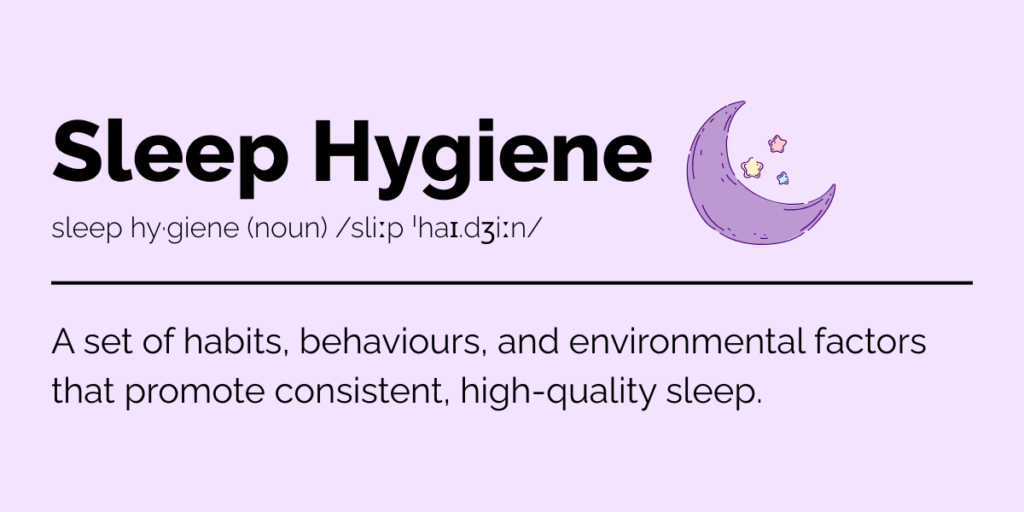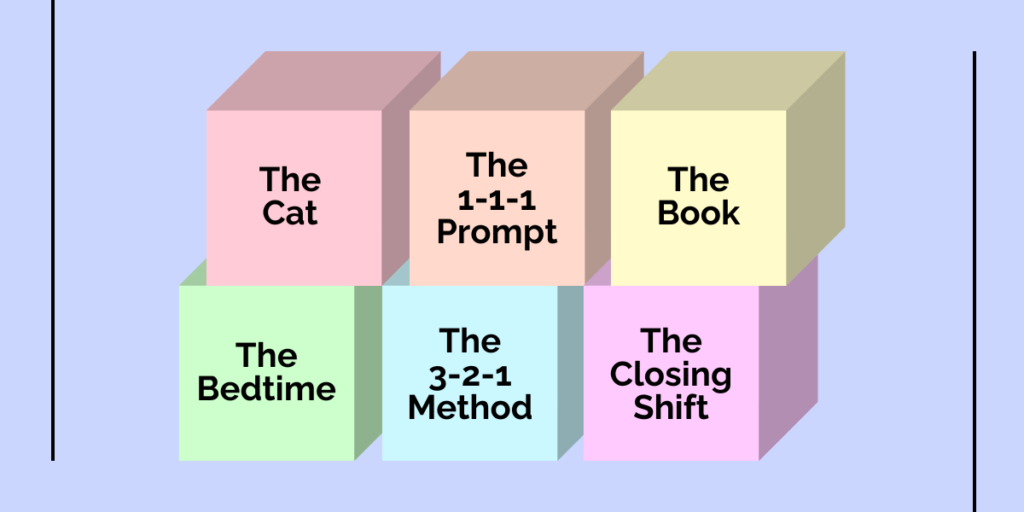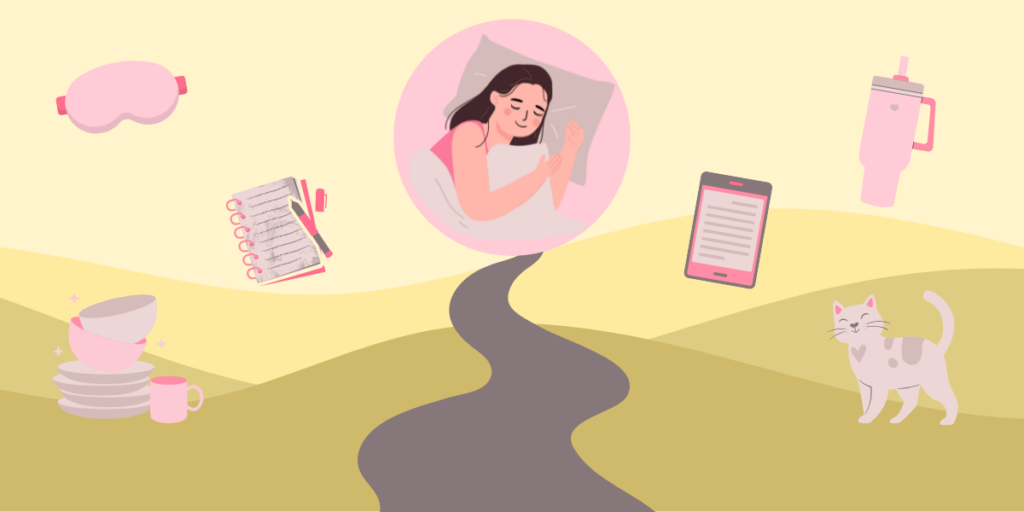I think we’ve all believed at one point or another that we’re just a solid morning routine away from the life that we’ve always wanted.
Especially when you see that people like Benjamin Franklin, Michelle Obama, Warren Buffet, Jeff Bezos, and Oprah Winfrey all swear by their morning routines. Unfortunately, it takes a little more than morning meditation and sunlight to be successful and happy – however you define those terms for yourself.
Does this mean I’m against morning routines? Absolutely not – I wholeheartedly believe that wellness routines can set you up for success. And the secret ingredient to every good morning routine is a good night routine! (See what I did there?)
In this article, I’m going to cover what first got me interested in establishing a night routine for myself, how it’s improved my life, how I make it sustainable, and the routine itself. If you keep falling off your night routine or can’t stick with your morning routine, I hope this article will provide some clarity and insight on the subject or at least give you some ideas for your routines!
Yes, Sleep Hygiene Is a Thing

I couldn’t tell you when I first heard the term, but when more and more YouTubers like Keltie O’Connor and Ali Abdaal started talking about sleep hygiene, I started to become more aware of my sleep habits.
Yes, duh, obviously sleep’s important, but I didn’t really understand the scope of it.
Studies show that about one-third of the adult population is sleep-deprived, and poor-quality sleep can negatively impact your mental health, cognitive function, hormone balance, and immune system, as well as increase your risk of heart disease, diabetes, and weight gain.
Lately, there’s been a surge of interest in “sleep maxxing,” a term popularized on TikTok that essentially means optimizing every possible factor to achieve the best sleep quality. It’s the latest evolution of sleep hygiene, but with a more intense, almost competitive edge—think blackout curtains, temperature-controlled rooms, magnesium supplements, and high-tech sleep masks. My biggest concern with this trend is when it compels people to spend all this money on products they don’t really need. I found a cheap sleep mask that I love, but I’m not about to go buy an Eight Sleep mattress. Also, if you have access to a family doctor, definitely ask them before starting any new supplements, Magnesium or otherwise.
Sleep Maxxing ties into the broader trend of sleep gamification, where smart wearables like the Oura Ring, WHOOP, and Fitbit now track everything from your sleep cycles to your HRV (heart rate variability) and assign you a sleep score. While these tools can be great for awareness, they can also create anxiety around sleep, which ironically makes it harder to get good rest. I question how accurate these wearables really are, so I take the sleep data from my Fitbit with a grain of salt.
My relationship with sleep started with lots of naps – and no, I’m not referring to the ones I had to take in daycare. I’m talking all through high school my mom would often come home from work to find me napping in the chair in front of the TV. I didn’t think much of it, teenagers need lots of sleep. Then in college my sleep was all over the place, so there were many times I’d set an alarm for a quick 10-minute nap between classes. Again, it still felt within the realm of normal – college, am I right?
Now that I was in my early 20s and working in a hybrid position, mostly from home, I would still take a nap almost every day. Some days I simply felt sleepy, and some days I was depressed and wanted a break from being awake – if you know, you know. So at this point, my naps were getting a little out of hand. There was a key element missing from my life – physical activity!
You need to spend energy to get energy. I know, it seems counterintuitive, but next time you’re a little sleepy in the afternoon, try going for a quick walk and see if you feel more energized. I bet you will!
When I started my fitness journey around 23 years old, I napped less and less as I exercised more and more. This also empowered me to get a better handle on my mental health to stop taking those damn depression naps as well. I still didn’t have a routine, though.
Getting 7 to 9 hours of sleep every night isn’t enough to get restful sleep. There are other factors to consider, like how long it takes you to fall asleep, how many times you wake throughout the night, how long it takes to fall back asleep, and last but not least, having a fixed wake-up and bedtime. That’s right, folks, bedtimes are back.
Now that we all agree that yes, sleep is a huge pillar in your health, let me walk you through how I built a night routine that’s sustainable and covers all the bases.
The Building Blocks of My Night Routine

The Bedtime
This is something I continue to wrestle with because this bedtime isn’t exclusive to school nights; we’re talking the weekend too. (Yes, I’ve been out of school for 10 years, and I still call them school nights.)
Since I run my business by myself from home, I really have a lot of flexibility here. So you best believe I was sleeping until 10 am for a while. However, there’s this phenomenon that I can’t seem to explain: around four o’clock, I lose all motivation to work. I think, “Ah yes, the work day is over, I can relax now.” Even if my work day didn’t start until noon. I know what you’re thinking: just keep working anyway, right? Well, you try writing ads or designing landing pages when all you can think about is dinner and watching the latest episode of Kitchen Nightmares. The creative output is nowhere to be found. So, instead, after a totally reasonable amount of time, I realized the solution was to just wake up earlier so I had a bigger time frame to get work done.
I figured waking up at 6:30 seemed realistic, so subtract 8 hours, and that gave me a new bedtime of 10:30 pm.
The 3-2-1 Method
Having chosen my bedtime made it all the more easy to use this method that I came across from Dan Go. The 3-2-1 method is a simple way to wind down effectively and improve sleep quality:
- 3 hours before bed – No more food. This gives your body enough time to digest so it’s not working overtime while you’re trying to sleep.
- 2 hours before bed – No more liquids. This helps prevent waking up in the middle of the night for a bathroom trip.
- 1 hour before bed – No more screens. Avoiding blue light and overstimulation makes it easier to fall asleep when your head hits the pillow.
Of course, I don’t always follow this perfectly—sometimes I’m late to get dinner on the table or date night takes priority—but even sticking to it most nights has made a huge difference in how well I sleep. Honestly, the hardest part of this was filling that last hour of the day without screens! This is where the rest of the building blocks come into play.
The Closing Shift
This simple framework is what finally got me to clean my home consistently. I call it The Closing Shift because it reminds me of when I worked at Scoops Ice Cream as a teenager. When I was closing up for the night—mopping the floors, doing the dishes, cleaning the frozen yogurt machine—I always made sure to do a really good job, especially if I had the dreaded open-close shift the next day. Nothing was worse than walking into a messy workspace first thing in the morning.
I didn’t come up with The Closing Shift myself—I’ve heard others use the term, and I loved it so much that I adopted it for my own routine. Now, I apply it to my kitchen. Before bed, I make sure all the dishes are done—either left in the drying rack or put away—and I wipe down the counters so everything is fresh for the next day. That way, when I wake up, I’m not immediately greeted by a sink full of dishes or a sticky countertop. Instead, I can just make my coffee and ease into my morning without unnecessary stress. It’s a small shift, but it makes a huge difference in how my day starts.
The Cat
Every night when I climb into bed, it’s not long before my cat, Harley Quinn, hops in behind me. Given her portly stature, she can’t quite reach everywhere when grooming herself, so the vet recommended I brush her every day. I figured—what better time than when we’re already cozy in bed together, winding down for the night?
This has been a newer addition to my night routine, and honestly, it might be my favourite. There’s something so calming about the quiet rhythm of brushing her, especially when she starts purring. People often assume she’s standoffish and doesn’t like attention, but the truth is, she’s just a little sassy about when and how she receives it. And now that she gets daily brushing sessions on her terms, her coat is noticeably fluffier—it’s a win-win!
The 1-1-1 Prompt
One of my New Year’s resolutions was to start journaling regularly. This resolution isn’t new—I’ve tried (and failed) to stick with it before. The closest I got was writing down one thing I was grateful for each day, and while I kept that up for a while, it never really felt like proper journaling. I wanted something that would help me reflect more deeply, but without feeling like a chore.
Everything changed when I came across Sahil Bloom’s 1-1-1 Method on Instagram a couple of months ago. It’s a simple yet effective framework that makes journaling feel both meaningful and manageable. Here’s how it works:
Every evening, at the end of your day, open up your journal (or favourite digital tool) and jot down three simple points:
- 1 win from the day – Something you accomplished, big or small.
- 1 point of tension, anxiety, or stress – Getting it out of your head and onto paper is surprisingly therapeutic.
- 1 point of gratitude – A moment, person, or thing that made you feel thankful.
The whole process takes about five minutes—though if I’m feeling inspired, I’ll sometimes write more.
The beauty of the 1-1-1 Method is in its simplicity. It encourages self-reflection without the pressure of writing a full journal entry. One win keeps me motivated, one challenge helps me process my thoughts, and one moment of gratitude shifts my focus to the positive. Since starting this habit, I’ve actually enjoyed journaling for the first time ever, and that’s saying something!
But, let’s be real—sometimes I struggle to come up with a win or a point of tension, depending on how my day went. It’s like looking for a snack in the fridge and not finding anything. My trick? Lower your standards and look again, and you’ll find something! If I really can’t pick just one thing for each point, that’s okay too. Some days, I list multiple wins, stresses, or moments of gratitude. Journaling doesn’t have to be rigid. As long as I feel like I’ve cleared my mind and reflected on the day I just lived, I consider it a win.
The Book
I used to have the hardest time actually falling asleep when the time came. Just lying there alone with my thoughts? No thanks. Another problem I had was whenever I tried to curl up with a book in the afternoon, I’d always fall asleep. It wasn’t that the book was boring—it was just the act of reading that made my eyes heavy. So, what did I do? I added reading to my night routine, of course!
Some nights it works within 10 minutes, and I’m out cold. Other nights, I can get through a chapter or two before I start nodding off. I read until I can’t keep my eyes open anymore, then I close my book—well, Kindle. One of the greatest gifts I ever got was being able to lie on my side without having to hold up pages. I mean, seriously, why didn’t anyone tell me about this sooner? The dark mode option is also a game-changer for reading in low light.
The only time this strategy didn’t work was when I was deep in my thriller phase, reading books like Verity and The Housemaid. I was so riveted, my eyelids never got heavy. Moral of the story: Choose your books wisely!
The Actual Night Routine
7:30 pm: Last meal of the day
8:30 pm: Last sip of water
9:30 pm: Closing shift
9:35 pm: Brush teeth & wash face
9:45 pm: Brush cats
9:50 pm: Journal
10 pm: Read
10:30 pm: Sleep
Your Path to a Better Night's Sleep

Building a solid night routine has been a game-changer for me. From setting a consistent bedtime to embracing the 3-2-1 Method, making time for a closing shift in my home, bonding with my cat, journaling with the 1-1-1 Prompt, and winding down with a good book, each of these small practices has added up to a much better night’s sleep—and a more peaceful mind.
If you’re struggling to create your own night routine, don’t be discouraged. The key is consistency and flexibility. You don’t have to follow every step to the letter—just find what works for you and make it a habit. The beauty of routines is that they can evolve as your life and needs do. Remember, a good night routine is like a cog in your wellness machine, helping everything else in your life function more smoothly. (If you’re interested in learning more about building your wellness system, keep an eye out for an upcoming article on this!)
I encourage you to try incorporating some of these strategies into your own life. Whether you stick to one or implement them all, you’ll be on the right track to better sleep, better health, and a more relaxed you.
Now, I’d love to hear from you: What’s your favourite part of your night routine? Drop a comment below and share your go-to wind-down ritual—I can’t wait to see what works best for you!

